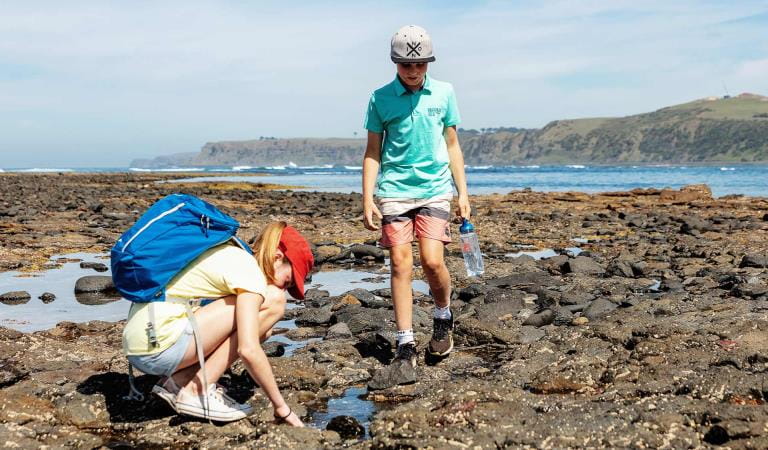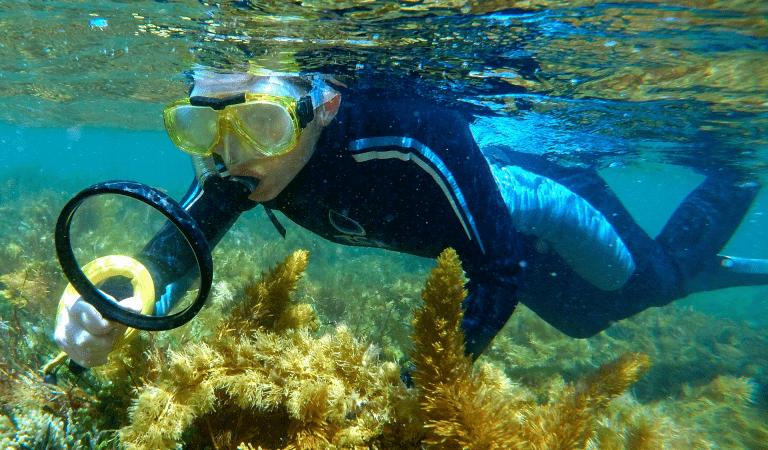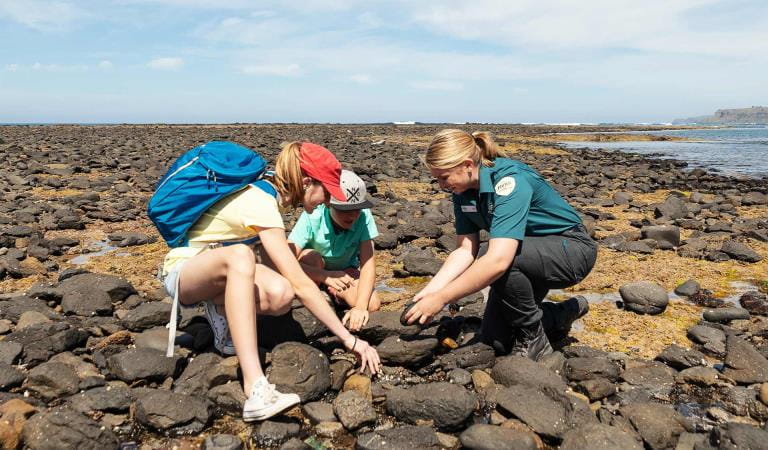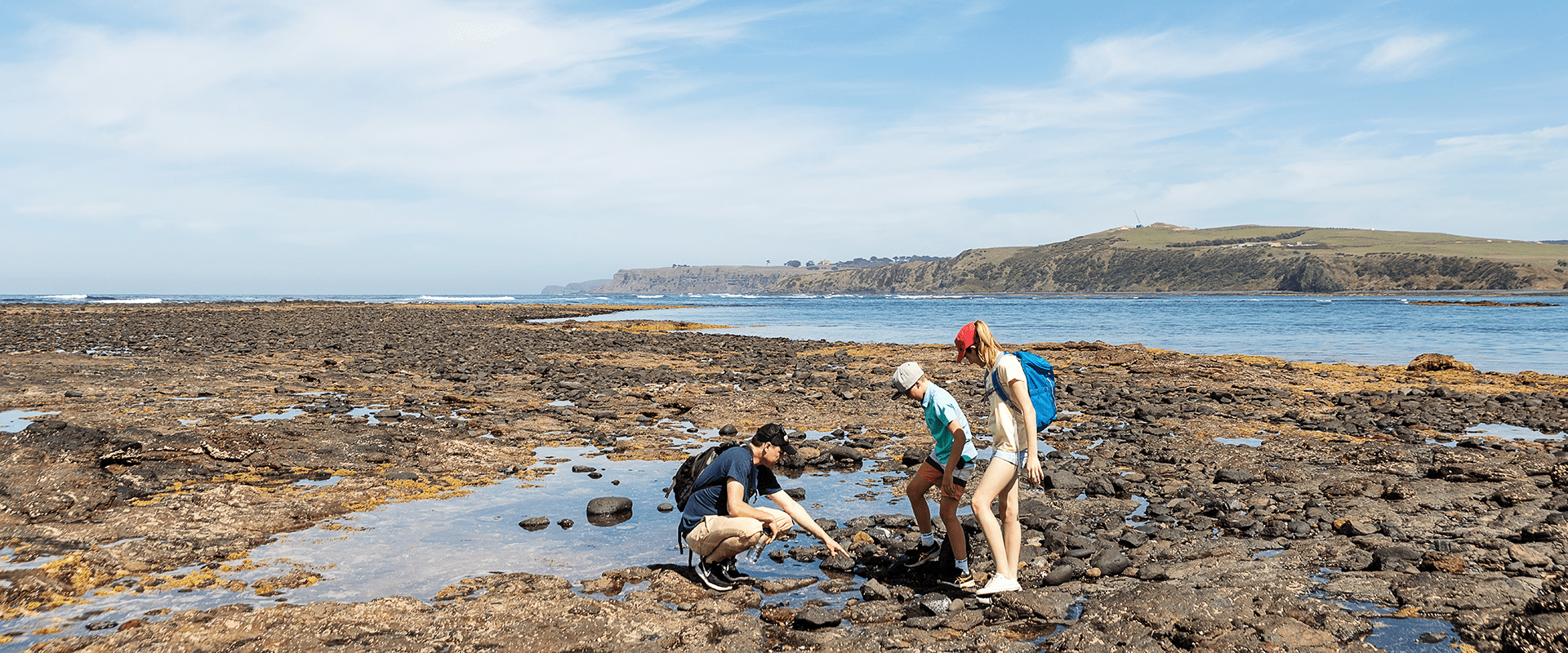Explore
Mushroom Reef Marine Sanctuary
Mushroom Reef Marine Sanctuary is a special and family-friendly spot for marine discovery. The sea withdraws at low tide to expose a huge mushroom-shaped ‘platform’. A line of cobbles stretches out to sea from Flinders Ocean Beach, forming the stalk of the mushroom. At the tip, sections of reef branch out on either side. Other reefs lie to the left and right and further out to sea, making a mosaic of sheltered bays and pools.
The reefs and rocks are home to diverse marine life, thanks to the ‘micro-habitats’ formed in the cracks and crevices of ancient basalt and seagrass meadows in the surrounding seabed. These unique underwater landscapes allow many different marine creatures to live close together. You'll want to return to the sanctuary time and time again, as visiting at different times of the year will allow you to see different marine species.
You may be very lucky and spot the amazing Black and White Sea Star, one of only two sea stars known to brood its young in its belly. Get up close by snorkelling or diving, and see fish such as Saddled Wrasse, Magpie Morwong and the strange box-like Cowfish moving through the seaweed fronds. Watch the Weedy Seadragons, Victoria’s marine state emblem, as they beat their small fins to hover over the seagrass beds.
Take a wander along the sands at Flinders Ocean Beach. Try some beachcombing and climb up to the lookout for sweeping sea views. This park is also a good place to see Pied Oystercatchers, Ruddy Turnstone and small migratory shorebirds such as the Red-necked Stint.
Scientists and naturalists have been discovering unique new species of marine creatures at Mushroom Reef for more than a hundred years. Today, it’s just as popular with tourists and schoolchildren who want to learn about these amazing underwater worlds for themselves. The best time to visit the sanctuary and explore the rockpools is around low tide, 2 hours on either side.
Remember to take only photographs and memories: to keep the sanctuary ecosystem healthy and safe, collecting shells and marine life from the sanctuary is not allowed.
Things To Do

Rock pooling

Diving and Snorkelling

Sea Search Intertidal Reef Monitoring program
Mushroom Reef Marine Sanctuary
Anemones, Black and White Sea Star, Saddled Wrasse, Magpie Morwong, Cowfish, Weedy Seadragons, crabs, Elephant Snail, Chiton, Sea Hare, Intertidal Slug, Dog Winkle, Blue-ringed Octopus, Shore Crab, Bryozoan, and Biscuit Star all call this sanctuary home.
Keep an eye out for:
Tours and adventure experiences in parks
One of the best ways you can get into nature is with a Licensed Tour Operator.
There are more than 400 Licensed Tour Operators across Victoria who are ready and waiting to help you experience and connect with Victoria’s spectacular parks and waterways.
Discover more than 60 different types of nature-based experiences including hiking, mountain biking, boating, four-wheel driving, indigenous culture tours, birdwatching, surfing, diving and so much more.
Licensed Tour Operators know all the best places to go and will plan and prepare your visit to ensure you are safe and can enjoy your nature-based adventure to the fullest.
How to get there
Mushroom Reef Marine Sanctuary
When you're there
Download the Mushroom Reef Marine Sanctuary Visitor Guide for more information about the park and a map.
The best time to visit the sanctuary and explore the rockpools is around low tide, 2 hours on either side.
Visit the sanctuary at different times of the year to see the different marine species.
When to go
Warm and usually calmer water. Look for Sea Hares that visit the sanctuary. You may even find their egg mass - these look like bright orange or yellow 2-minute noodles. New shoots of Neptune Necklace appear in the rockpools and this is the best time for all species of plants and animals to grow and reproduce. Summer is the best time for snorkelling or scuba diving in the warmer water.
Need to know
Mushroom Reef Marine Sanctuary
Accessibility
There is wheelchair access to the carpark and viewing platform. Beach access is limited to beach wheelchairs only.
Visiting a park can be more of a challenge for people with disabilities, however in Victoria there are a wide range of facilities to help people of all abilities enjoy our wonderful parks around the state.
Assistance dogs are welcome in Parks Victoria parks and reserves. Entry requirements apply for parks and reserves that are usually dog prohibited, such as national parks.
Safety
Mobile phone coverage may not be reliable in the marine sanctuary. If you are boating, carry the safety equipment required under the Marine Safety Act, which varies depending on the class of vessel and the areas and types of waterways in which it's operated.
Check the marine weather report. Beware of sudden changes in weather, especially when boating on open water. Practice safe boating and follow all signs and markers correctly. Carry a chart and if possible a GPS.
Wear closed shoes with good grip when walking on rock platforms. Stay away from cliff edges and bases and beware of large unexpected waves.
Never put your hands where you cannot see your fingertips, such as under seaweed or rocks, to avoid dangerous creatures.
Be aware of strong currents and undertows when swimming and snorkelling.
Scuba diving should only be undertaken by experienced and qualified divers.
Change of Conditions
Nature being nature, sometimes conditions can change at short notice. It’s a good idea to check this page ahead of your visit for any updates.
-
Flinders Ocean Beach (Mushroom Reef Marine Sanctuary, Mornington Peninsula National Park)
Mushroom Reef Toilet Closure Finders Ocean Beach
The toilet at Flinders Ocean Beach, Mushroom Reef is permanently closed. The nearest alternative public toilets are Flinders town centre public toilets.Landslip affecting beach west of Mushroom Reef, Flinders Ocean Beach
There is a landslip affecting the beach west of Mushroom Reef, Flinders Ocean Beach (within Mornington Peninsula NP). Please do not approach the slip.
How we keep it special
The Management Plan for Mushroom Reef Marine Sanctuary directs management of the park until the plan is reviewed.
The Mushroom Reef Marine Sanctuary is a protected area and visitors are not allowed to collect or damage any animals, plants and objects, including dead shells.
Fishing from the shore or at sea is prohibited in the marine sanctuary. On-shore boundary markers define the area of the Marine Sanctuary.
There are strong penalties under the National Parks Act for fishing in marine national parks and marine sanctuaries. To report a fishing offence call the Victorian Fisheries Authority on 13 FISH (13 3474).
The sanctuary is patrolled by Rangers and Fisheries Officers to enforce these regulations.


